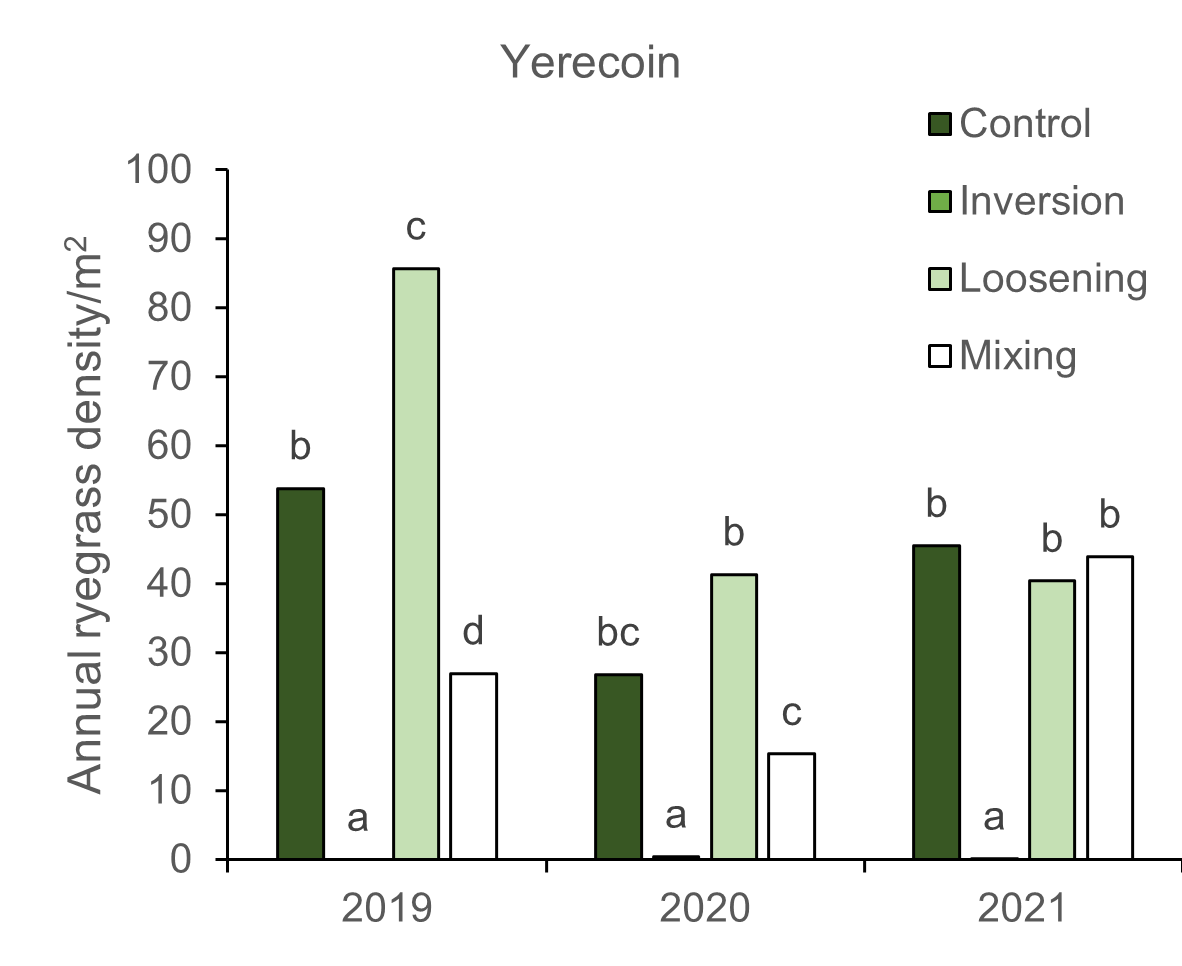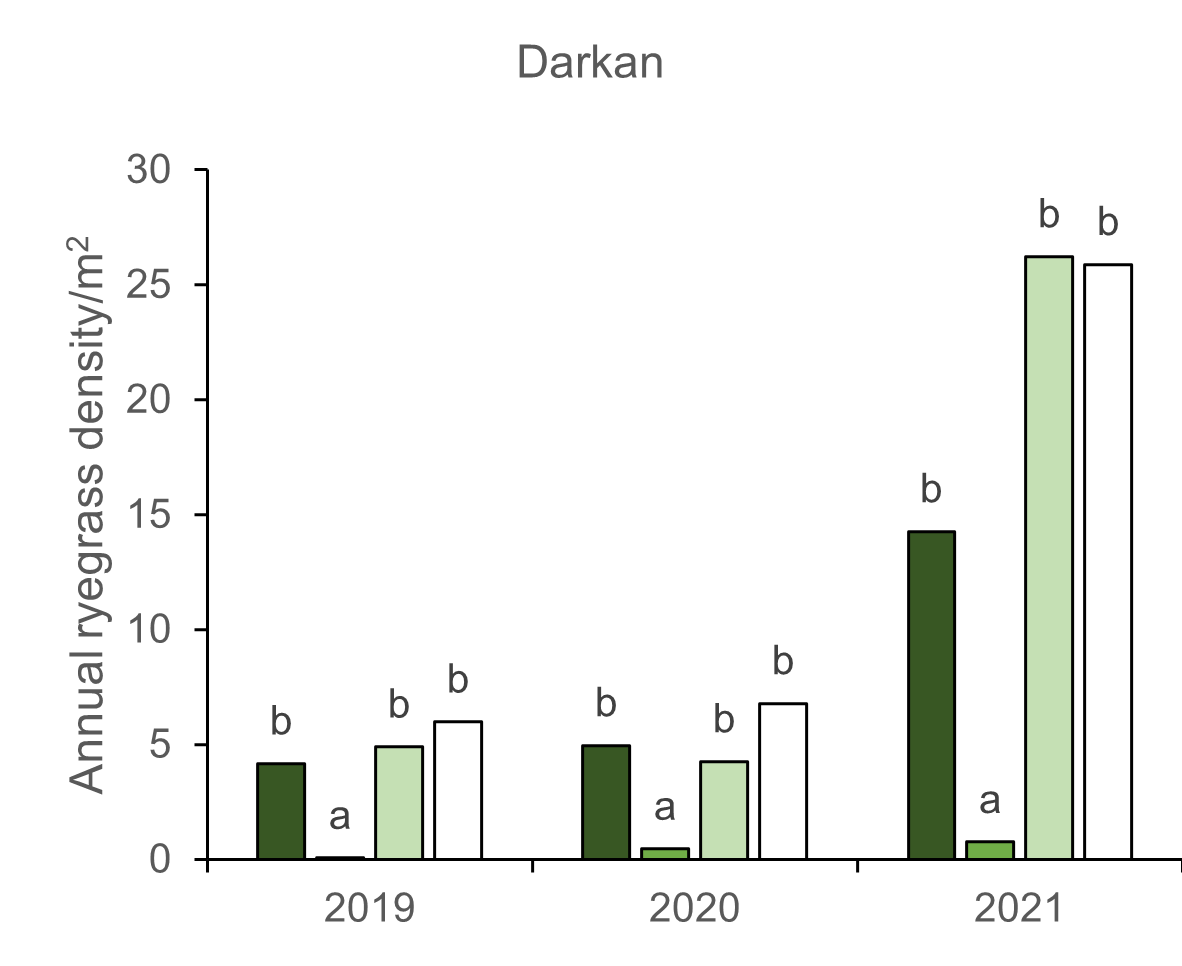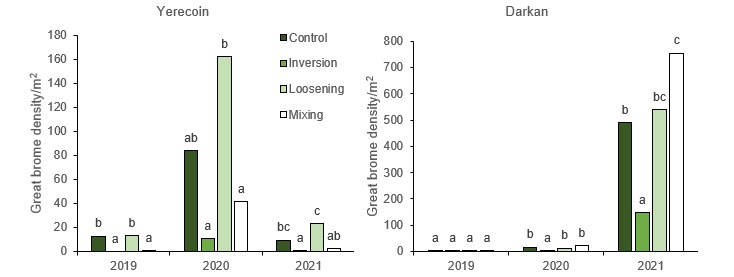Strategic tillage: how does it impact weed management?
Strategic tillage: how does it impact weed management?
Author: Catherine Borger, Sarah Collins, Stephen Davies, George Mwenda, Gaus Azam and Arslan Peerzada | Date: 27 Feb 2023
Key Messages
- Seed burial depth varies widely between soil types, soil conditions and implement setup, even when using the same soil tillage implements at a consistent speed. Therefore, check the depth of working to estimate weed seed burial.
- A full soil inversion (mouldboard) buries seed to approximately half the working depth.
- Seed burial by soil mixing (spading or ploughing) or loosening (deep ripping) is highly variable, depending on the soil type. However, there is no consistent evidence that these amelioration techniques stimulate weed emergence (as is observed after an autumn tickle).
- How well a weed species recovers after burial depends on both burial depth and seed size. A species with a large seed like great brome is more likely to emerge successfully from a greater burial depth than a small seeded species like annual ryegrass.
Introduction
Amelioration to address soil constraints is common in Western Australia. A full soil inversion using a mouldboard plough is a great weed control technique. However, there is very little information on the impact of burial via amelioration on weed seeds of different sizes. Existing work in Western Australia focuses on small seeded species like annual ryegrass or wild radish, and international work on seed burial is often conducted using plastic beads rather than weed seeds (Newman, 2011; Mia et al 2023). There is very little information on the impact of soil loosening (deep ripping) or mixing (rotary spader) on topsoil and weed seed burial or subsequent weed growth, but it is assumed that these techniques may stimulate weed emergence, similar to an autumn tickle (Mia et al 2023). This study used three sites where contrasting soil was ameliorated via a full inversion, loosening or mixing. We aimed to determine how weed seeds were buried by amelioration and how weed density was impacted in the crop in a three-year rotation after amelioration.
Method
Field trials were established at Yerecoin, Darkan and Williams, Western Australia (Table 1). Each trial had amelioration treatments applied to a moist soil, at the beginning of the growing season, after the opening rain. Treatments included:
- Control – no amelioration.
- Soil loosening – 2m wide Agroplow deep ripper, operating depth of 35-45cm, five tines, 40cm tine spacing, operating speed of 4km/h.
- Soil mixing – Yerecoin: Imants 3m wide, 3-point-linkage rotary spader with power harrows, operating speed of 4km/h). Darkan: combination of Agroplow deep ripping with topsoil inclusion plates and shallow ploughing with Kverneland mouldboard plough to 20cm, operating speed 4km/h. Williams: McCormick International A1-41 4-disc plough, operating depth 15-20cm, operating speed 4 km/h.
- Soil inversion – Kverneland mouldboard plough, three (number 9) plough boards, in-furrow plough with skimmers, operating speed of 4km/h.
While soil amelioration was undertaken with the same implements, at the same speed at each site, the degree of mixing and depth of working was dependant on soil type and condition (Table 1). Crop in 2019 was sown after amelioration treatments. At Williams, different crops were sown in 2019 and 2020. Amelioration was conducted at the start of 2021, and a bulk barley crop was sown over the entire area in the following years to determine the impact of timing of the amelioration event within the rotation (crop rotations in Table 1). It is important to note that for all sites, regionally appropriate herbicides were applied for weed control in each year. The herbicides removed broadleaf weed species like wild radish (Raphanus raphanistrum L.) but did not fully control grass weeds. In 2021, in-crop control was affected by lack of access due to the very wet season. At all three sites, the most common grass weeds were annual ryegrass (Lolium rigidum Gaud.) and great brome (Bromus diandrus Roth).
Table 1. Field trial location, soil type, trial design, amelioration date and crop rotation after amelioration
Location | Yerecoin | Darkan | Williams |
Site location | -30.8920, 116.3871 | -33.3963, 116.8796 | -32.8949,116.7842 |
Soil type | Yellow orthic Tenosol (sand) | Bleached-ferric dystrophic yellow Chromosol, with 40% subrounded ferruginous ironstone gravel and 10% subrounded ferruginous ironstone stone at 0-20 cm (sandy loam with gravel) | Ferric mesotrophic yellow Chromosol (duplex sandy gravel) |
Trial design | Randomised block design, amelioration as the factor, six replications. Plots of 1.54m by 20m. | Split plot design, initial crop species (2019 and 2020, barley cv. LaTrobe, canola cv. Nuseed GT-53, lupin cv. Jenabillup, serradella cv. Elisa) as the main plot factor, amelioration as the subplot factor, six replications. | |
Amelioration date (and average depth) | 14/06/2019 (35-37cm) | 19/05/2019 (25-32cm) | 23/03/2021 (12-24cm) |
Crop rotation* | Barley – wheat – RR canola | Barley – wheat – RR canola | Barley – barley |
*Amelioration at Williams in 2021 (crop monitored over 2021-2022), compared to amelioration at Yerecoin and Darkan in 2019 (crop monitored over 2019-2021).
The sites were assessed each year for initial weed density (after application of in-crop herbicide) from 2-4 quadrats (50cm by 50cm) per plot. Soil cores (five per plot) at Yerecoin/Darkan, with an auger of 4cm diameter) were taken from depths of 0-10, 10-20, 20-30 and 30-40cm, in three of the six replications, and cores of each depth were bulked from each plot. Emergence trays of 30cm by 30cm by 10cm were filled with potting mix to within 2cm of the top. Bulked soil cores were used to fill trays to the top. Trays were maintained in an irrigated screen house and emerged seedlings were counted and removed for one year.
Weed density was analysed using an ANOVA, where amelioration (and crop species at Williams) was the factor. All annual ryegrass density data except for Darkan 2019 was subject to a square root transformation to ensure normal distribution of the residuals. Likewise, great brome data from Yerecoin and Darkan in 2019 and 2021 was subject to square root transformation and data from Darkan in 2020 was subject to a cube root transformation. Data are presented as back-transformed mean values.
Results
Seed burial
The three sites had contrasting soil types and the Williams site had dense, hard soil. As a result, strategic tillage reached depths of over 30cm at Yerecoin and Darkan, but Williams had a maximum amelioration depth of 24cm (Table 1). Seed burial varied widely between the sites. Full soil inversion buried about 90% of weed seeds at 10-20cm at Yerecoin and Darkan. By comparison, at Williams the weed seeds after amelioration were still at 0-10cm, the same as the control plots (Table 2). Seeds were not placed at the maximum working depth of soil inversion at any site. Soil loosening was the only tillage technique that reliably put a proportion of seed at the maximum working depth, but the percent of seed buried by loosening or soil mixing was highly variable between the sites.
Table 2. Field site, amelioration technique and percent of weed seeds (annual ryegrass and great brome seed) buried at varying depths
Location | Amelioration technique | 0-10cm | 10-20cm | 20-30cm | 30-40cm |
Yerecoin | Control | 78 | 22 | 0 | 0 |
Full soil inversion - mouldboard | 11 | 89 | 0 | 0 | |
Loosening - deep ripping | 91 | 7 | 2 | 0 | |
Soil mixing - rotary spader | 31 | 58 | 11 | 0 | |
Darkan | Control | 78 | 22 | 0 | 0 |
Full soil inversion - mouldboard | 12 | 87 | 1 | 0 | |
Loosening - deep ripping | 33 | 33 | 33 | 1 | |
Soil mixing - rotary spader | 70 | 21 | 9 | 0 | |
Williams | Control | 100 | 0 | 0 | 0 |
Full soil inversion - mouldboard | 100 | 0 | 0 | 0 | |
Loosening - deep ripping | 75 | 25 | 0 | 0 | |
Soil mixing - rotary spader | 100 | 0 | 0 | 0 |
Weed growth
At both Yerecoin and Darkan, annual ryegrass density was close to zero after the soil inversion in 2019 and remained low in 2020 and 2021 (density ranging from zero plants to less than 1 plant/m2 from 2019 to 2021, Figure 1). By comparison, soil loosening or mixing had very little impact on weed density. At Yerecoin in 2019, loosening had slightly greater annual ryegrass density than the control, but weed density was similar to the control in 2020 and 2021. At Darkan, loosening had no impact on density. Soil mixing initially reduced weed density at Yerecoin, but density was similar to the control in 2020 and 2021. Soil mixing did not impact annual ryegrass density at Darkan.


Figure 1. Annual ryegrass density at Yerecoin and Darkan from 2019 to 2021. At both sites, soil amelioration (control, full soil inversion, loosening or soil mixing) was performed directly before sowing the crop in 2019 (Table 1). Letters indicate a significant difference (from the LSD at P: 0.05) in density between amelioration techniques within each separate year.
Soil inversion reduced great brome grass density at Yerecoin in 2019, but by 2020 there were 11 plants/m2. At Darkan, great brome density in all amelioration treatments was too low to be significantly different in 2019. In subsequent years, density was reduced compared to the other treatments, but had reached 147 plants/m2 by 2021. Loosening had no impact on great brome grass. Soil mixing in 2019 reduced density at Yerecoin compared to the control, but in 2020 and 2021 soil mixing was similar to the control. In Darkan, soil mixing plots initially had similar density to the control but had increased plant density by 2021.

Figure 2. Great brome density at Yerecoin and Darkan from 2019 to 2021. At both sites, soil amelioration (control, full soil inversion, loosening or soil mixing) was performed directly before sowing the crop in 2019 (Table 1). Letters indicate a significant difference (from the LSD at P: 0.05) in density between amelioration techniques within each separate year.
At Williams, annual ryegrass and great brome density remained similar between amelioration techniques in both years (data not presented).
Conclusion
It is a general (international) rule-of-thumb that during a full soil inversion, most weed seeds are placed at roughly half the total depth of amelioration (Mia et al 2023). This occurred at all three sites in the current study. At Yerecoin and Darkan, weed seed burial was sufficient to reduce in-crop weed density in the following three years. In the highly compacted soil at Williams, with a maximum working depth of 18cm and weed seeds at 0-10cm, there was no impact of soil inversion on subsequent weed density.
The necessary burial depth to reduce emergence depends on weed seed characteristics. Seeds of annual weed species can differ greatly in terms of size, shape, weight, type and level of seed dormancy, triggers for breaking dormancy, maximum depth of emergence, and recruitment signals (Long et al 2015). Annual ryegrass has a small seed, and emergence is substantially reduced at 5cm depth (Chauhan et al 2006). Great brome has a photosensitisation requirement for emergence (i.e., seeds are more likely to emerge if they are buried), and a proportion will emerge from up to 15cm depth (Borger et al 2021). Therefore, weed seed burial at 10-20cm at Yerecoin and Darkan would prevent the emergence of annual ryegrass, but not fully prevent emergence of great brome seedlings. While great brome density was substantially lower in the soil inversion plots at these two sites, the populations were recovering quickly. At Yerecoin there were 10 plants/m2 in 2020 (note that in-crop plant density was recorded after herbicide application), but the RR canola in 2021 successfully reduced the population. In Darkan, the very wet conditions in 2021 delayed in-crop weed control and there were 147 great brome/m2 in the RR canola. It is clear that growers need to develop a comprehensive integrated weed management plan for great brome after a full soil inversion, to take advantage of seed burial and maintain the population at low levels.
The impact of soil loosening and mixing on seed burial and subsequent weed growth was highly variable between sites. It has generally been considered that these soil amelioration techniques may stimulate weed growth (similar to the impact of an autumn tickle) (Mia et al 2023). However, our results indicated that these techniques do not reliably change weed emergence and density.
Acknowledgments
Research was funded by DPIRD (Royalties for Regions) through project ‘The impact of soil amelioration on weed ecology and control’ and by the GRDC and DPIRD co-investment project ‘DAW1901-006RTX Increasing farming system profitability and longevity of benefits following soil amelioration’. The research undertaken as part of this project is made possible by the significant contributions of growers through both trial cooperation and GRDC investment; the author would like to thank them for their continued support. We would also like to thank DPIRD staff Sultan Mia, Daniel Huberli, Carla Wilkinson, Andrew van Burgel, Sean Kelly, Kris Gajda, Melanie Kupsch, Bowen Zhang, Chad Reynolds, Nerys Wilkins, Dave Nicholson, Helen Hunter and Ken Flower (UWA). Thanks to Miranda Slaven for reviewing this paper.
References
Borger, C.P.D., Torra, J., Royo-Esnal, A., Davies, L. and Newcombe, G. (2021) Chapter 4. Bromus diandrus and Bromus rigidus. In: Chauhan, B.S. (Ed). Biology and Management of Problematic Crop Weed Species. London, UK: Academic Press, Elsevier Inc. pp. 67-88.
Chauhan, B.S., Gill, G. and Preston, C. (2006) Influence of environmental factors on seed germination and seedling emergence of rigid ryegrass (Lolium rigidum). Weed Science 54, 1004-1012.
Long, R.L., Gorecki, M.J., Renton, M., Scott, J.K., Colville, L., Goggin, D.E., Commander, L.E., Westcott, D.A., Cherry, H. and Finch-Savage, W.E. (2015) The ecophysiology of seed persistence: a mechanistic view of the journey to germination or demise. Biol Rev Camb Philos Soc 90, 31-59. 10.1111/brv.12095
Mia, S.M., Azam, G., Nouraei, S. and Borger, C. (2023) Strategic tillage in Australian conservation agricultural systems to address soil constraints: how does it impact weed management? Weed Research 63, 12-26. https://doi.org/10.1111/wre.12564
Newman, P. (2011) Mouldboard ploughing of sandplain soils-more grain, fewer weeds. In: Proceedings Agribusiness Crop Updates. (eds Paterson, J. and Nicholls, C.). Perth, Western Australia. 143-146. Department of Agriculture and Food, Western Australia.
Contact details
Dr Catherine Borger
Department of Primary Industries and Regional Development
75 York Rd (PO Box 483) Northam WA 6401
Ph: 0467 816 082
Fx: 08 9622 1902
Email: catherine.borger@dpird.wa.gov.au
GRDC Project Code: DAW1901-006RTX,
